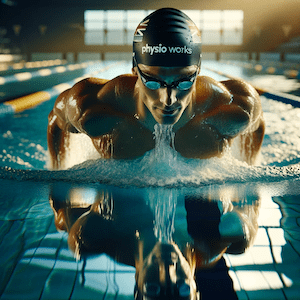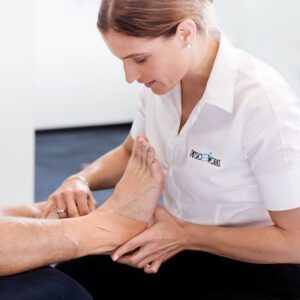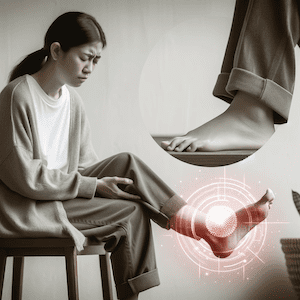
Common Swimming Injuries
Swimming is a fantastic sport that combines all body strength, flexibility, and endurance. Swimmers are unfortunately prone to overuse injuries. The most common swimming injury regions are the shoulder, lower back, and knee.

Shoulder Pain in Swimmers
Current data suggests that more than 30% of swimmers will miss competition or training due to injury. Of that population, over one-third of these injuries are concerning shoulder pain. Additionally, up to 91% of swimmers aged 13-25 years old experience shoulder pain frequently. “Swimmer’s shoulder” is an umbrella term used to describe numerous injuries that relate both to the swimming population and shoulder injuries. Due to the structural and biomechanical complexity of the shoulder, many factors relating to the swimming stroke can contribute to pain. Specifically, pain can either be local to the injured shoulder or refer to other body areas, namely the thoracic, cervical and upper arm regions. Elite swimmers are generally performing approximately 2500 shoulder revolutions per day, and thus, most issues surrounding the shoulder are attributed to an overuse phenomenon.
Irrespective of competitive level, the most prevalent of injuries surrounding the swimming population is shoulder pain. Both intrinsic (tendon morphology, vascularity) and extrinsic (acromion formation, stroke biomechanics, muscular imbalances) can influence how and why a swimmer experiences shoulder pain. An example of an extrinsic factor is crossing the midline during hand entry – this leads to an increase in internal rotation and resultant mechanical rotator cuff related shoulder pain (RCRSP). However, the pain produced is known to be multifactorial as opposed to a singular cause and can be influenced by the following issues:
- Stroke biomechanical abnormalities
- Overuse, fatigue or improper control and utilisation of the muscles of the shoulder, scapula and upper back
- Glenohumeral (shoulder) laxity
Shoulder pain is thought to be primarily due to the muscular imbalance between the dominant muscles (adductors, internal rotators) and stabilising muscles (rotator cuff). Consequently, this leads to muscle activation and control deficits, causing a superior and anterior translation of the humeral head generally accompanied by tightening the shoulder’s posterior capsule. This superior translation and inadequate control results in the humeral head colliding with soft tissue structures (supraspinatus, subacromial bursa, biceps tendon), subsequently manifesting as RCSHP.
You can further exacerbate pain and discomfort if the swimmer continues to train at the same level of intensity and frequency as pre-injury.
More Info: Swimmer’s Shoulder.
Knee Pain in Swimmers
Although less common, injury to the knee is prevalent in the swimming population and is almost exclusively reserved for the breaststroke population due to the nature of the kick. Overuse is once more the primary culprit here, with repetitive stress placed on the medial knee and producing pain during the whip-like motion.
The breaststroke kick is a high valgus load produced during sudden flexion-extension, adduction and external rotation of the knee against the hydrodynamic environment, resulting in stress to the medial compartment. The result, therefore, is a strain to the medial collateral ligament and compression on the lateral knee. Consequently, it is not uncommon for swimmers to present with ligament sprains on the MCL, irritation of the medial plica and bursal irritation at the muscular insertions of the adductor and hamstring muscles. Furthermore, strain injuries can be present in the adductor muscles (adductor magnus and brevis, especially).
Abnormalities in turning ability (quick knee flexion-extension during the somersault) can result in anterior knee pain such as patellofemoral pain syndrome. This condition arises from patella mal-tracking or quadriceps strength and is consistently amenable to physiotherapy input and intervention.
More info: Breaststroker’s Knee
Low Back Pain in Swimmers
Because of its prevalence within the general and sporting population, low back pain can result from swimming. As swimming athletes are positioned horizontally in the water, gravity and buoyancy forces are travelling through the body with the potential to cause changes in the lumbar spine. Due to the undulating motion (lumbar extension) utilised in butterfly and breaststroke, there is potential for developing pain secondary to stress on the joints.
Moreover, tightness in the hip flexors or inadequate body roll during swimming may lead to compensation at the lumbar spine.
More info: Swimmer’s Back Pain
Swimming Injury Treatment
Overall, your swimming physiotherapist will aim to treat your immediate pain and restore normative function during your first few sessions. Once this has been completed, further assessment will identify reasons exploring how and why the injury came on to help reduce recurrence in the future and keep you in the pool.
Treatment may involve manual therapy, massage and/or exercise prescription, but more importantly, finding the root cause of the injury and modifying stroke technique to prevent the issue from reoccurring. Any further questions about the above injuries or prevention, please consult your PhysioWorks swimming physiotherapist.
Prevention is Key!
Evidence suggests that injury management should focus on prevention and early treatment intervention. Addressing your specific impairments associated with the condition and analysing training methods and stroke mechanics all assist in quickly returning you to your pain-free best in the pool.
A large part of managing an injury involves communication between parents, coaches, and your physiotherapist to enhance recovery and prevent injury.
Swimming Injury Risk Screening
PhysioWorks has a swimmer screening service available both in the clinic and at your pool for the whole squad. Don’t hesitate to contact us for more information about our swimmer screening and injury prevention program.
Common Swimming Injuries
Shoulder Pain
- Swimmers Shoulder
- Shoulder Impingement
- Rotator Cuff Syndrome
- Rotator Cuff Tear
- Shoulder Bursitis
- Shoulder Tendinopathy
- Biceps Tendinopathy
Knee Pain
- Breaststroker’s Knee
- Medial Collateral Ligament Stress Syndrome
- Patellofemoral Syndrome
- Medial Synovial Plica Syndrome
Back:
Foot and Ankle:
- Tendinitis of the extensor tendons
Elbow:
Wrist and Hand:
Rochedale - Call 38410277
Book Online: RochedaleSalisbury - Call 32751044
Book Online: SalisburySandgate - Call 32691122
Book Online: SandgateArticle by Zoe Russell
Sports Physiotherapy FAQs


Sports Physiotherapy is the specialised branch of physiotherapy which deals with injuries and issues related to spokespeople. Practitioners with additional formal training within Australia are Sports & Exercise Physiotherapists.
What is Sports Physiotherapy?
Sports injuries do differ from common everyday injuries. Athletes usually require high-level performance and demands placed upon their bodies, which stresses their muscles, joints and bones to the limit. Sports physiotherapists help athletes recover from sporting injuries and provide education and resources to prevent problems. Each sports physiotherapist usually has sport-specific knowledge that addresses acute, chronic and overuse injuries. Their services are generally available to sportsmen and women of all ages engaged in sports at any level of competition.
Members of Sports Physiotherapy Australia (SPA) have experience and knowledge of the latest evidence-based practice, professional assessment and diagnosis of sports injuries, and effective hands-on management techniques and exercise protocols to assist recovery and prevent future damage. SPA members have access to the most recent advances in sports physiotherapy. You'll be pleased to know that most PhysioWorks physiotherapists and massage therapists are particularly interested in sports injury management.
General Sports Physio FAQs
- Sports Physiotherapy
- Acute Sports Injury Clinics
- Sports Physiotherapy Treatment
- Youth Sports Injuries
Injury Management
- Sports Injury? What to do? When?
- When Can You Back to Sport?
- Sports-Related Injuries
- Knee Sports Injuries
- Sports Health Conditions
Sports Massage
Sports Insurance
Related Articles
- Sports Injury Management: This article provides a comprehensive look at how sports injuries are managed, including prevention strategies and treatment options.
- Soft Tissue Injury Healing: Readers can learn about the healing process for soft tissue injuries, including practical advice for each phase of recovery.
- Prehabilitation: Key to Injury-Free Sports Performance: Offers insights into how athletes can prevent injuries before they occur, focusing on strengthening and conditioning practices.
- Athletics Injuries - Comprehensive Physio Guide: A detailed guide on common injuries in athletics and how to treat and prevent them, making it a valuable resource for athletes of all levels.
- Acute Sports Injury Clinic: Highlights the services offered by sports injury clinics, including fast-track assessments and treatments for acute sports injuries.
- Effective Management of Kids Sports Injuries: This guide focuses on the unique aspects of managing sports injuries in children, offering parents and coaches valuable advice on care and prevention.
More Information
Rochedale - Call 38410277
Book Online: RochedaleSalisbury - Call 32751044
Book Online: SalisburySandgate - Call 32691122
Book Online: SandgateCommon Muscle Injuries
A Physiotherapist's Guide
Introduction
Muscle injuries, presenting as muscle strain, pain or myalgia, are prevalent health issues affecting a wide range of individuals. This detailed guide, from a physiotherapist's perspective, delves into various muscle injuries, elaborating on their management, prevention, and the importance of professional advice. Explore the linked articles for an in-depth understanding of muscle injuries and their effective treatment.
Neck & Back Muscle Injuries: Causes and Solutions
- Back Muscle Pain: This pain often results from prolonged poor posture or physical overuse. Key to relief is engaging in exercises that strengthen the core muscles and improve posture, thereby alleviating the strain on the back.
- Neck Sprain: Caused by sudden, awkward movements, a neck sprain can benefit from a combination of gentle stretches and targeted strengthening exercises to restore flexibility and strength.
- Text Neck: A modern ailment resulting from extended mobile device use, text neck can lead to chronic pain. Regular breaks, posture-awareness, and neck-strengthening exercises are essential for prevention.
- Whiplash: Commonly occurring in car accidents, whiplash requires a careful approach including neck stabilisation exercises and controlled movement to encourage healing and prevent further injury.
Lower Limb Muscle Injuries: Understanding and Treating
- Hamstring Strain: Particularly common among athletes, particularly runners, this strain demands rest initially, followed by a carefully structured rehabilitation program focusing on gradual strength building and flexibility.
- Thigh Strain: Often seen in sports involving sprinting and jumping, thigh strains need a combination of rest, ice, compression, and elevation (RICE) in the initial stages, followed by carefully planned strengthening exercises.
- Groin Strain: This injury requires a nuanced approach, including sufficient rest and targeted exercises, to ensure a safe and effective recovery.
- Calf Muscle Tear: Key to recovery is a balance of rest, gentle stretching exercises, and a gradual return to full activity, ensuring the muscle heals correctly and strength is regained.
Upper Limb Muscle Injuries: Prevention and Care
- Golfer's Elbow and Tennis Elbow: Both these conditions involve inflammation of the tendons and require a rest period, followed by ice therapy and specific exercises tailored to strengthen the affected muscles.
- Corked Thigh: Resulting from direct impacts, these injuries demand immediate application of ice and a controlled, gradual exercise regime for recovery.
- DOMS, Fatigue-Related Cramps & Myalgia: Adequate rest, good hydration, and gentle stretching are crucial in alleviating these conditions.
- RSI: Regular stretching, ergonomic workplace adjustments, and taking breaks are key preventive measures for repetitive strain injury.
Systemic Causes of Muscle Pain: A Holistic View
- Fibromyalgia: This complex condition demands a holistic treatment approach, including exercise routines, stress management techniques, and sometimes medication.
- Rheumatoid Arthritis: Effective management combines medication, gentle exercise, and regular physiotherapy sessions.
Prevention and Management Strategies
- Regular Exercise: Regular physical activity helps maintain muscle strength and flexibility, reducing the risk of muscle injuries.
- Posture Improvement: Good posture, both in motion and at rest, is crucial for preventing muscle strain.
- Proper Warm-up and Cool-down: Adequate warm-up before and cool-down after physical activity is vital in preventing muscle strains and injuries.
- Ergonomic Adjustments: Making ergonomic adjustments at work and during daily activities can significantly reduce the risk of repetitive strain injuries and other muscle-related issues.
- Maintaining a Healthy Weight: Keeping a healthy weight reduces the strain on muscles, particularly in weight-bearing joints.
What to Do? Seeking Professional Advice
Consult a physiotherapist or doctor for personalised advice and treatment plans. Remember, early intervention can significantly improve recovery outcomes and prevent chronic problems.
Conclusion
While muscle injuries are common, effective management and prevention are achievable with the right approach and knowledge. Understanding the causes, symptoms, and various treatments available empowers individuals to take proactive steps in their recovery and prevention. For the most tailored and effective treatment, always seek the guidance of a professional physiotherapist.
Rochedale - Call 38410277
Book Online: RochedaleSalisbury - Call 32751044
Book Online: SalisburySandgate - Call 32691122
Book Online: SandgateCommon Ligament Injuries


Ligament Injury
Ligament injuries frequently occur in various body parts, leading to pain and restricted movement. The most common sites include the knee, ankle, shoulder, wrist, hand, and spine.
Notably, knee injuries like ACL, PCL, MCL, and LCL sprains are prevalent.
Shoulder injuries often involve the AC joint, while wrist and hand issues can include thumb and finger sprains.
Spinal ligament injuries, such as back and neck sprains, and whiplash, are also significant. Understanding these injuries helps in prevention, early detection, and effective treatment.
- Ankle Ligament Injuries
- Knee Ligament Injuries
- Shoulder Ligament Injuries
- Wrist & Hand Ligament Injuries
- Spinal Ligament Injuries
Ankle Ligament Injuries
Ankle injuries often result from sudden twists or rolls, leading to sprains and strains.
Knee Ligament Injuries
Knee ligament injuries are among the most common and can severely impact mobility and quality of life.
- ACL Injury
- PCL Injury
- MCL Sprain
- LCL Sprain
- Posterolateral Corner Injury
- Patella Dislocation
- Superior Tibiofibular Joint Sprain
Shoulder Ligament Injuries
Shoulder ligament injuries can be debilitating, affecting a range of movements.
Wrist & Hand Ligament Injuries
Injuries in the wrist and hand are common, especially in sports and physical activities.
Spinal Ligament Injuries
Spinal ligament injuries can result from various causes, including posture issues and physical impacts.
Related Articles
- Ligament Tear - Common Ligament Injuries: Offers a comprehensive overview of ligament injuries across different body parts, including prevention, early detection, and effective treatment strategies.
- Knee Ligament Injury - A Physiotherapist's Guide & Tips: Provides insights into diagnosing knee pain, covering ligament issues among other concerns, and suggests pain relief methods through exercise and treatment.
- Common Ankle Ligament Injuries: A Physiotherapist's Guide: Discusses the treatment and prevention strategies for ankle ligament injuries, emphasising the importance of early intervention.
- Sprained Ankle Treatment & Recovery Guide: Offers detailed guidance on the recovery timelines for sprained ankles, highlighting the importance of restoring strength, motion, and function for a full recovery.
- Ankle Strapping: Complete Guide To Injury Prevention: Focuses on preventing ankle injuries through effective strapping techniques and discusses conditions like ankle arthritis and biomechanical issues.
- Sub-Acute Soft Tissue Injury: Explores the treatment and recovery process for various ligament injuries, including those affecting the knee, shoulder, wrist, hand, and spine.
- Sprained Thumb Treatment And Recovery Tips: Delivers practical tips for treating and recovering from a sprained thumb, along with general management strategies for wrist and hand pain.













































































